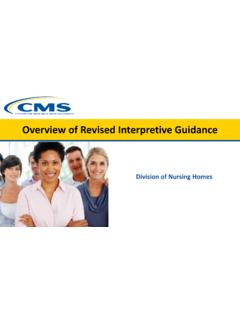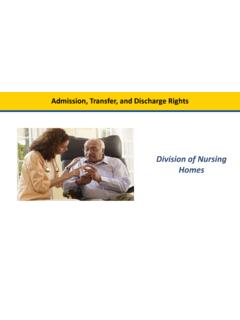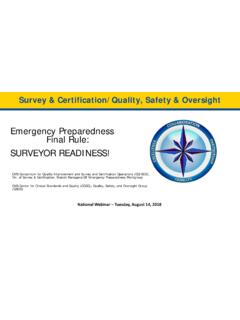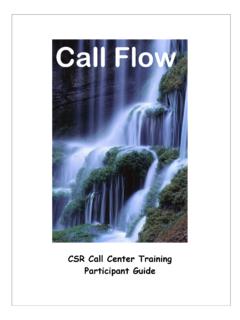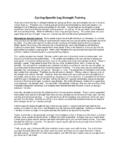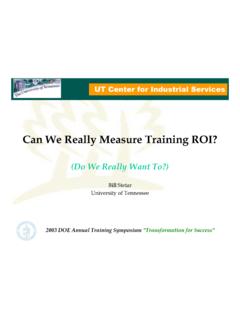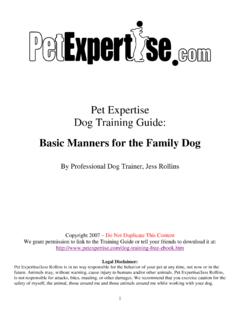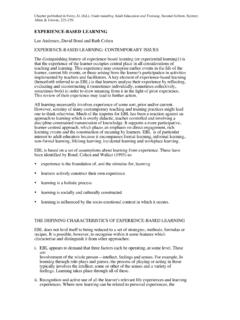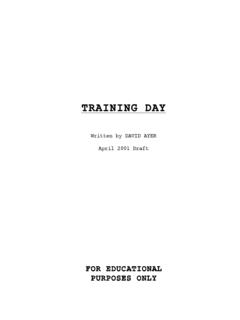Transcription of This is [Synora Jones] from CMS and myself and [Kellie ...
1 This is [Synora Jones] from CMS and myself and [Kellie Jakaitis] will be doing the training . The goal of today's presentation is to cover the changes to ASPEN In addition, we will highlight some of the areas that surveyors have asked about or have been struggling with. LTCSP 1. There is an updated LTCSP Procedure Guide. For this presentation, I will first show the changes made to the tool using a training survey. At the end of the presentation we will discuss the changes to the Procedure Guide. During this training , we will tell you which step in the Procedure Guide we are covering so you can take notes if you'd like. However, we would really like for you to watch the screen as I demonstrate the changes. LTCSP 2. Turn to Step 5 in the updated LTCSP Procedure Guide. One of the major changes included in this release is how the system handles complaints or FRIs being investigated with the survey. During offsite prep, the TC. will link all outstanding complaints or FRIs with the system.
2 This will allow the system to pull forward all complaint/FRI information throughout the survey. On the Offsite Prep screen, you can see the complaint section has been revised. This is the section that lists any complaints or FRIs being investigated with the survey. I'll first discuss the information included in the new active complaint/FRI. section and then we will complete the steps for including the complaints and FRIs into our training survey. LTCSP 3. Each row will include a distinct complaint or FRI intake. For each intake, you will see the Intake ID which is pulled forward from ACTS. When you click on the Intake ID you will see any notes entered by the State Agency in ACTS. As you can see, when I click on the first intake ID listed the ACTS note indicates the concern is regarding quarterly statements. LTCSP 4. The next column will show whether the intake is related to a complaint (COMP) or FRI. As you can see, for our training survey, we have two FRIs and five complaints that will be investigated with the survey.
3 Each intake will also pull forward the Complaint Resident Name from ACTS. You may see three possible scenarios under the Complaint Resident column. The first scenario is that the name may be blank like the first intake. This means that there is no resident associated with the complaint and the allegation is a general concern for the facility. The second possibility is that the intake person in the State added the name Anonymous, Anonymous in ACTs. The second intake is an example of that. Again, this means the complaint isn't associated with a resident and the concern is generalized to the facility. If you find that a resident is identified but was not added in ACTS, add the resident in ACTS, export the shell, but do not override the data. If we found that a resident was identified when we read the intake note, we would want to go back to ACTS, remove the anonymous designation and add the resident's name. The last scenario is that the complaint or FRI resident's name was entered in ACTS and will be listed.
4 The remaining complaints show the resident name entered in ACTS. The column titled LTCSP Resident-Room displays the list of residents included in the survey shell when the shell was exported from ACO. In order for the system to LTCSP 5. know which complaint or FRI residents are being included in the survey, the TC will have to link the ACTS complaint or FRI resident with the resident name listed in the system. If there isn't an ACTS resident name like the first intake, the system will automatically default the LTCSP resident to the general placeholder titled Facility, Facility. That way the system knows the complaint isn't specific to a resident. If the ACTS complaint resident's name is Anonymous, the TC will have to select the general Facility placeholder which is at the top of the drop down list. For any ACTS. complaint or FRI resident listed, the TC will see if the resident is listed under the LTCSP resident list. If the resident is listed, the TC will select the resident's name.
5 If the resident isn't in the LTCSP Resident List, you can add the resident with the Add New Resident button at the top right of the table. There is also an indicator if the complaint or FRI resident is also an offsite selected resident. None of the complaint or FRI residents included in our training shell were also selected offsite. Then you see a column where the TC can check which complaint or FRI residents will be included in the initial pool. Remember, the team can only include five complaint or FRI residents. If the complaint or FRI isn't linked to a resident, then the box to include the resident in the initial pool is deactivated since the generalized complaint or FRI will apply to all of the residents in the initial pool and doesn't impact the five residents that can be included. The final column is where the TC will assign the surveyor responsible for the complaint or FRI resident in the initial pool. LTCSP 5. To review the allegations associated with each intake ID, expand the intake ID using the down arrow.
6 If you click on the allegation you can read any notes that were entered in ACTS. You can see the complaint allegation is in regards to privacy and the residents being exposed when taken to the shower room. So the system knows which area is linked to the allegation, the TC will add the specific area in middle column that is associated with the allegation. You will use the Add Initial Pool Care Area option for resident in the initial pool and the allegation is covered by the initial pool OR for general complaints covered by the initial pool. You will use the Directly Add New Investigation option, if the resident is not going to be included in the initial pool because there are more than five complaint/FRI residents or for an allegation area that isn't covered by the initial pool such as an Ftag that isn't mapped to the initial pool like self-administration of meds. The resident and any added investigation will be displayed on the assigned surveyor's investigation screen.
7 If the allegation is related to a Facility Task, add the applicable area which will be displayed on the facility task screen. Triggered facility tasks and sufficient staffing will also be displayed on the initial pool screens. Finally, if the allegation is related to a Closed Record, add the closed record area which will be displayed on the closed record screen. Once you add an area, it will be listed in the last column. If a complaint is marked as a state-only, licensure complaint in ACTS, the complaint LTCSP 6. will be identified as such on the Offsite Prep screen. It is up to the State how they handle state-only complaints. LTCSP 6. Now let's complete the steps for our outstanding complaints and FRIs. Let's review the FRI allegation for the first intake. The concern is that residents are not getting quarterly statements as noted under the intake ID. There aren't any allegation notes since there weren't any notes entered in ACTS. For our training survey, we know the state has a system to document the full allegation details under the Intake ID so we will only review the intake ID notes.
8 This allegation is related to personal funds so we will add the triggered task under the Link or Add Facility Tasks option. Since this concern isn't linked to a specific resident, all of the initial pool residents will show this area of concern so you are reminded to review the area during the initial pool. In addition, the facility task screen will show that the personal funds task is related to a FRI allegation. LTCSP 7. Before we move to the next intake, you can see that Personal Funds is now listed next to the Facility Task label. Let's review the allegations for the next complaint. The allegation is around residents being taken down the hallway covered in a sheet and are exposed. Before I add the facility placeholder since the allegation isn't specific to a resident, notice that the initial pool indicator option is available. LTCSP 8. Once I add the general facility placeholder, you can see that the option to include the resident in the initial pool is gone.
9 LTCSP 9. The complaint allegation is related to privacy which is covered by the initial pool. Let's add privacy using the initial pool option. Since this concern isn't linked to a specific resident, all of the initial pool residents will show this area of concern so you are reminded to review the area during the initial pool. LTCSP 10. Once you add an initial pool area for a complaint that is not linked to a resident, the initial pool area will be listed for every non-resident specific intake next to the Care Areas label. As you can see Privacy is now listed for the first two complaints/FRIs. LTCSP 11. Let's review the 3rd area which is related to a FRI. The resident, Charles Arnold, was just admitted to the facility and an aide on the day shift was rough during care. First we need to link the ACTS resident name to the LTCSP resident name. As you can see Arnold isn't in the resident list. That means we will have to add the resident to the resident list.
10 LTCSP 12. To add the resident to the resident list I'll click on the Add New Resident icon above the table. I'll add the resident's name and mark FRI as the subgroup. Once you are onsite and confirm the resident is a new admission, you can add that subgroup on the Resident Manager screen. You will also identify the surveyor who will be assigned to the resident during the initial pool. I will leave the complaint resident assigned to Kelly. You do not need to add a room number or admission date if those pieces of information aren't known. You can add them once you get onsite. Then click Save. LTCSP 13. Once you have added the resident, select the resident from the drop-down. LTCSP 14. The resident will be automatically included in the initial pool. If you do not want to include the resident in the initial pool deselect the checkmark in the In Pool column. For our training survey since we only have five complaint/FRI residents, we will leave Arnold in the initial pool and keep the resident assigned to Kelly.
